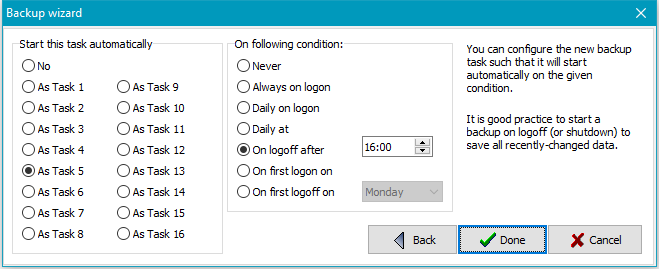

Here in this example, /root/rpmpkgs contains some rpm package files and you want that directory to be copied inside /tmp/backups/ folder.

The following command will transfer or sync all the files from one directory to a different directory in the same machine. Rsync Local Files Copy/Sync a Directory on Local Computer In the above example, you can see that if the destination is not already existed rsync will create a directory automatically for the destination. Sent 224.54K bytes received 70 bytes 449.21K bytes/sec Here in this example, a file name backup.tar needs to be copied or synced to /tmp/backups/ folder. The following command will sync a single file on a local machine from one location to another location. Copy/Sync Files and Directory Locally Copy/Sync a File on a Local Computer
#Automatic backups with grsync install#
We can install the rsync package with the help of the following command in your Linux distribution. -h : human-readable, output numbers in a human-readable format.
#Automatic backups with grsync archive#
-a : archive mode, which allows copying files recursively and it also preserves symbolic links, file permissions, user & group ownerships, and timestamps.-r : copies data recursively (but don’t preserve timestamps and permission while transferring data.The basic syntax of the rsync command # rsync options source destination Some common options used with rsync commands Rsync consumes less bandwidth utilization as it uses compression and decompression method while sending and receiving data on both ends.The first time, it copies the whole content of a file or a directory from source to destination but from next time, it copies only the changed blocks and bytes to the destination. It’s faster than scp ( Secure Copy) because rsync uses a remote-update protocol which allows transferring just the differences between two sets of files.Supports copying links, devices, owners, groups, and permissions.It efficiently copies and sync files to or from a remote system.Some Advantages and Features of Rsync Command You don’t need to be a root user to run the rsync command. This article explains 10 basic and advanced usage of the rsync command to transfer your files remotely and locally in Linux-based machines. Rsync Local and Remote File Synchronization With the help of the rsync command, you can copy and synchronize your data remotely and locally across directories, disks, and networks, perform data backups, and mirror between two Linux machines. Rsync ( Remote Sync) is the most commonly used command for copying and synchronizing files and directories remotely as well as locally in Linux/ Unix systems.


 0 kommentar(er)
0 kommentar(er)
